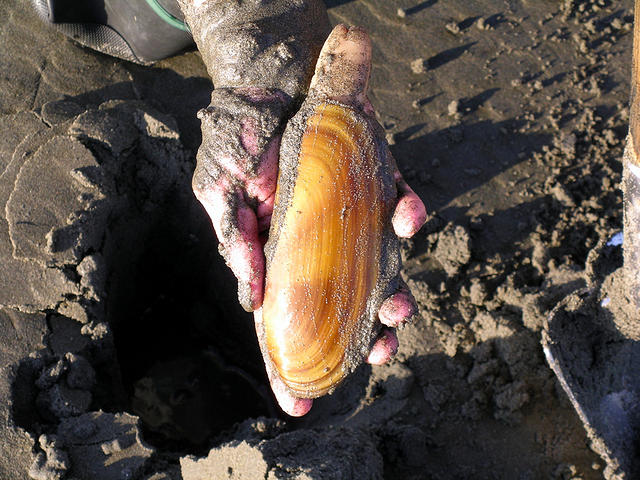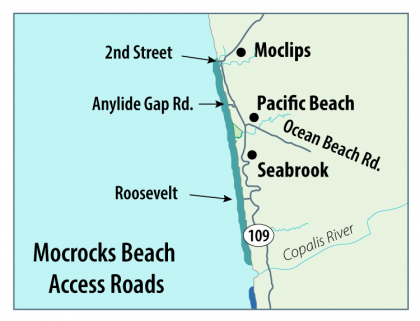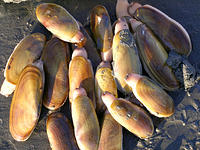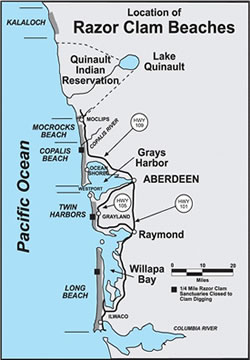WDFW Approves razor clam tides: May 10th- May 15thTides Last tides of the season. Halibut Season Starts May 1st Bottom Fishing opens March 8th
- Home
- Razor Clam Tides
Razor Clam Tides

WDFW Approved Razor Clam Tides:
The following digs during morning (am) low tides will proceed as scheduled, after marine toxin results from the DOH showed razor clams are safe to eat.
- May 10, Saturday, 5:58 a.m.; 0.1 feet; Long Beach, Twin Harbors, Copalis
- May 11, Sunday, 6:32 a.m.; -0.4 feet; Long Beach, Twin Harbors, Mocrocks
- May 12, Monday, 7:05 a.m.; -0.7 feet; Long Beach, Twin Harbors, Mocrocks
- May 13, Tuesday, 7:38 a.m.; -0.9 feet; Long Beach, Twin Harbors, Copalis
- May 14, Wednesday, 8:13 a.m.; -0.9 feet; Long Beach, Twin Harbors, Copalis
- May 15, Thursday, 8:49 a.m.; -0.8 feet; Long Beach, Twin Harbors, Mocrocks

WDFW approves of coastal razor clam digs beginning May 10th - May 15th Last Tides of the season
Approved dates during morning (midnight to noon only) low tides May 10-15:
- May 10, Saturday, 5:58 a.m.; 0.1 feet; Long Beach, Twin Harbors, Copalis
- May 11, Sunday, 6:32 a.m.; -0.4 feet; Long Beach, Twin Harbors, Mocrocks
- May 12, Monday, 7:05 a.m.; -0.7 feet; Long Beach, Twin Harbors, Mocrocks
- May 13, Tuesday, 7:38 a.m.; -0.9 feet; Long Beach, Twin Harbors, Copalis
- May 14, Wednesday, 8:13 a.m.; -0.9 feet; Long Beach, Twin Harbors, Copalis
- May 15, Thursday, 8:49 a.m.; -0.8 feet; Long Beach, Twin Harbors, Mocrocks
Clam Gun or Shovel
Check this out!
WDFW wants razor clam fans around the state to weigh in on the perennial question:
Which is better, clam gun or shovel?
To register support for a favored digging method, clam diggers can post a photo or video, complete with hashtag #TeamClamShovel or #TeamClamGun on any social media before the end of the spring season.

Many ocean beaches are open to motor vehicles, but drivers are required to follow the "rules of the road," said Ayres. “Mocrocks beach only has three points of road access, so we are asking beachgoers to arrive early and exercise good judgment when accessing the beach,” he added.
"Under state law, all vehicles - and horses - are required to travel along the extreme upper limit of the hard sand," he said. "When in doubt, follow the path marked by multiple tire tracks." Drivers who veer from that path pose a direct threat to fish and wildlife, Ayres said. Motorists who violate Washington state laws on beach driving can face a fine of $150, or much more for killing endangered seabirds, like snowy plovers.
“We manage recreational clam digging in Washington in a manner that we believe minimizes potential impacts to vulnerable ground nesting listed bird species,” said Ayres. “We do this by not scheduling digging after May 15 at key breeding areas for snowy plovers and streaked horned larks, including Long Beach and Twin Harbors.”
The agency continues to emphasize ‘digging while distancing’ and masking up when near others to support efforts by community health experts to ensure a fun and safe razor clam season.
The agency continues to emphasize ‘digging while distancing’ and masking up when near others to support efforts by community health experts to ensure a fun and safe razor clam season.
All diggers age 15 or older must have an applicable fishing license to harvest razor clams on any beach.
Licenses, ranging from a three-day razor clam license (starting at $9.70) to an annual combination fishing license, are available on WDFW's website and from some 600 license vendors around the state.
Under state law, diggers at open beaches can take 15 razor clams per day and are required to keep the first 15 they dig. Each digger's clams must be kept in a separate container.
Razor Clams

Please remember to check with Washington Department of Fish and Wildlife for last minute changes to the razor clam digging , rules and regulations.
Beaches in Washington with razor clam fisheries include:

Copalis Beach, which extends from the Grays Harbor north jetty to the Copalis River, and includes the Copalis, Ocean Shores, Oyhut, Ocean City and Copalis areas.
Mocrocks Beach, which extends from the Copalis River to the southern boundary of the Quinault Reservation near the Moclips River, including Iron Springs, Roosevelt Beach, Seabrook, Pacific Beach and Moclips.
Twin Harbors Beach, which extends from the mouth of Willapa Bay north to the south jetty at the mouth of Grays Harbor.
Long Beach, which extends from the Columbia River to Leadbetter Point.
Kalaloch Beach, which extends from the South Beach Campground to Brown’s Point (just south of Beach Trail 3) in the Olympic National Park.
 Webcam Westport, Washington
Webcam Westport, Washington